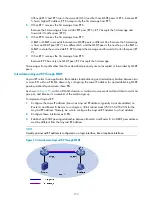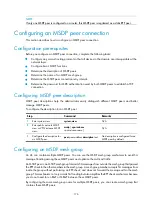
178
Step Command
Remarks
4.
Configure the interval
between MSDP peer
connection retries.
timer retry
interval
Optional.
30 seconds by default.
5.
Configure a password for
MD5 authentication used by
both MSDP peers to establish
a TCP connection.
peer
peer-address
password
{
cipher
cipher-password
|
simple
simple-password
}
Optional.
By default, MD5 authentication is
not performed before a TCP
connection is established.
Configuring SA message related parameters
This section describes how to configure SA message related parameters.
Configuration prerequisites
Before you configure SA message delivery, complete the following tasks:
•
Configure any unicast routing protocol so that all devices in the domain are interoperable at the
network layer.
•
Configure basic MSDP functions.
•
Determine the ACL rules for filtering SA request messages.
•
Determine the ACL rules as SA message creation rules.
•
Determine the ACL rules for filtering SA messages to be received and forwarded.
•
Determine the time to live (TTL) threshold for multicast packet encapsulation in SA messages.
•
Determine the maximum number of (S, G) entries learned from the specified MSDP peer that the
router can cache.
Configuring SA message content
Some multicast sources send multicast data at an interval longer than the aging time of (S, G) entries. In
this case, the source-side DR must encapsulate multicast data packet-by-packet in register messages and
send them to the source-side RP. The source-side RP transmits the (S, G) information to the remote RP
through SA messages. Then, the remote RP joins the source-side DR and builds an SPT. Because the (S,
G) entries have timed out, remote receivers can never receive the multicast data from the multicast source.
After the source-side RP is enabled to encapsulate multicast data in SA messages, if the RP wants to sends
a multicast packet, it encapsulates the multicast packet in an SA message and sends it. After the remote
RP receives the SA message, it de-encapsulates the SA message. Then, it delivers the multicast data that
is encapsulated in the multicast packet to the receivers in the local domain along the RPT.
The MSDP peers deliver SA messages to one another. After receiving an SA message, a router performs
RPF check on the message. If the router finds that the remote RP address is the same as the local RP
address, it discards the SA message. However, in the Anycast RP application, you must configure RPs
with the same IP address on two or more routers in the same PIM-SM domain and configure these routers
as MSDP peers to one another. Therefore, a logical RP address (namely, the RP address on the logical
interface) that is different from the actual RP address must be designated for SA messages so that the
messages can pass the RPF check.
To configure the SA message content:
















































